The Programmable Robots Market is estimated to be valued at USD 4.7 billion in 2025 and is projected to reach USD 20.1 billion by 2035, registering a compound annual growth rate (CAGR) of 15.7% over the forecast period. This trajectory underscores the accelerating adoption of robotics across education, industrial training, research, and consumer applications. From 2020 to 2025, the market experienced steady YoY growth, moving from USD 2.3 billion in 2020 to USD 4.7 billion in 2025, driven by increasing integration of robotics into STEM education and growing demand for hands-on learning tools.
Between 2025 and 2030, YoY growth accelerates as revenues rise from USD 5.4 billion in 2026 to USD 9.7 billion by 2030, fueled by widespread deployment in industrial prototyping, collaborative robotics (cobots), and DIY learning kits. This phase highlights the scaling stage, where programmable robots transition from niche applications to mainstream adoption. From 2030 to 2035, the market enters a consolidation phase, growing from USD 11.2 billion in 2031 to USD 20.1 billion by 2035. The YoY increments become larger in absolute terms, reflecting higher baseline revenues, while growth is supported by AI integration, IoT-enabled robotics, and demand for programmable service robots in healthcare and logistics.
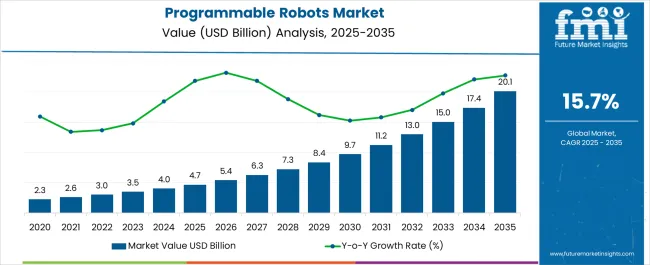
| Metric | Value |
|---|---|
| Programmable Robots Market Estimated Value in (2025 E) | USD 4.7 billion |
| Programmable Robots Market Forecast Value in (2035 F) | USD 20.1 billion |
| Forecast CAGR (2025 to 2035) | 15.7% |
The programmable robots market is gaining traction due to rapid advancements in automation, artificial intelligence, and STEM based education. Increasing adoption of robotics in manufacturing environments and the incorporation of coding and programming in educational curricula are key drivers behind market expansion.
Educational institutions are integrating programmable robots into learning frameworks to enhance practical problem solving and critical thinking among students. Simultaneously, manufacturers are deploying programmable robotic systems to optimize production efficiency, improve quality control, and reduce operational costs.
Ongoing innovations in sensor technology, mobility, and user friendly programming interfaces are broadening application potential across industries. As automation and digital literacy become cornerstones of industrial and educational transformation, the market for programmable robots is expected to see consistent growth driven by both institutional and commercial demand.
The programmable robots market is segmented by component, type, end use, and geographic regions. By component, the programmable robots market is divided into Hardware and Software. In terms of type, the programmable robots market is classified into Educational robots, Industrial robots, Service robots, Research robots, and Others. Based on end use, the programmable robots market is segmented into Manufacturing, Healthcare, Entertainment and media, Military and defense, and Others. Regionally, the programmable robots industry is classified into North America, Latin America, Western Europe, Eastern Europe, Balkan & Baltic Countries, Russia & Belarus, Central Asia, East Asia, South Asia & Pacific, and the Middle East & Africa.
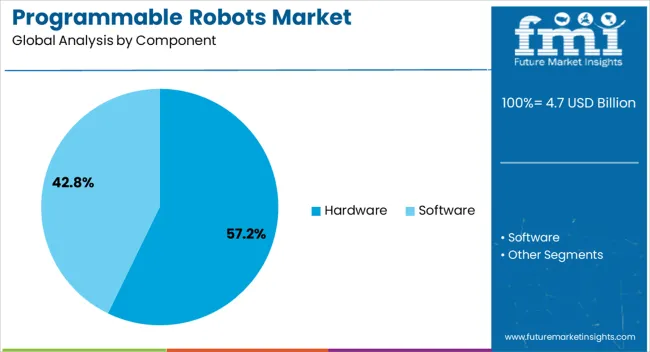
The hardware segment is projected to represent 57.20% of the total revenue by 2025 under the component category, making it the most dominant area of investment. This growth is supported by continuous innovations in robotic components, including microcontrollers, sensors, actuators, and communication modules.
These components form the structural and functional backbone of programmable robots, contributing to precision, flexibility, and adaptability in diverse tasks. Increased demand for advanced robotic kits and integrated hardware platforms in both education and industry has reinforced this segment's position.
With robotics becoming more modular and customizable, the hardware segment continues to lead due to its direct impact on robot capability and performance.

The educational robots segment is expected to account for 38.60% of the total market revenue by 2025 within the type category. This prominence stems from the growing emphasis on early exposure to coding and robotics in academic settings.
Educational robots serve as engaging tools to foster logical thinking, teamwork, and applied learning, making them ideal for classrooms, extracurricular programs, and robotics clubs. Governments and education boards globally are introducing robotics into STEM programs to align with future workforce requirements.
The affordability and versatility of programmable educational robots have made them accessible across a range of educational institutions, further contributing to segment growth and leadership.

The manufacturing segment is projected to command 42.90% of the total market share by 2025 under the end use category, emerging as the leading segment. This dominance is attributed to the increasing use of programmable robots in assembly, inspection, and packaging processes.
As manufacturers strive to meet higher production standards and flexibility, programmable robots offer cost-effective and scalable automation solutions. These systems are adaptable to various manufacturing environments and can perform complex tasks with minimal human intervention.
The rising need for precision and efficiency, coupled with labor shortages in certain regions, has intensified the adoption of programmable robots in manufacturing, solidifying this segment’s leading position in the overall market.
The programmable robots market is expanding quickly as industries, educational institutions, and consumers adopt robotics for automation, learning, and entertainment. These robots, which can be programmed to perform customized tasks, are increasingly used in manufacturing, logistics, healthcare, and STEM education. Rising demand for robotics in Industry 4.0, coupled with the growing importance of hands-on learning in coding and AI, is fueling adoption. North America and Europe dominate due to advanced robotics ecosystems, while Asia-Pacific shows strong growth with manufacturing automation and educational technology investments. Market growth is driven by innovation in AI integration, cost reduction, and collaborative robot applications.
The cost of developing programmable robots, including sensors, actuators, microcontrollers, and AI software, remains a challenge for widespread adoption. Small enterprises and schools often face budget limitations in adopting advanced robots for training or operational use. Furthermore, technical barriers such as complex programming, limited interoperability, and system integration issues hinder adoption among non-technical users. Until scalable, cost-efficient platforms with simplified programming interfaces become widely available, affordability and usability will continue to restrain market penetration, especially in emerging economies and small-scale enterprises.
Technological innovation is transforming programmable robots into smarter, more adaptive systems. Advances in AI, machine learning, natural language processing, and computer vision enable robots to learn tasks, interact naturally with humans, and optimize workflows. Collaborative robots (cobots) are gaining traction in industries where safety and flexibility are critical. In education, robotics kits with intuitive coding platforms and cloud-based programming tools expand accessibility for students. Companies leveraging AI-driven programming, wireless connectivity, and modular hardware designs are creating scalable solutions that appeal to both industrial and consumer markets.
The regulatory framework for programmable robots varies across regions, particularly in industrial and healthcare environments. Safety standards such as ISO 10218 and ISO/TS 15066 govern collaborative robots and industrial robot use, ensuring worker protection. Educational robots face fewer regulatory hurdles but must comply with consumer electronics safety standards. Inconsistent regulations across geographies can complicate market entry for global players. Manufacturers aligning with safety certifications and regulatory requirements enhance trust and broaden market opportunities, especially in sectors such as healthcare and industrial automation where compliance is mandatory.
The programmable robots market is highly competitive, with players ranging from global robotics leaders to educational robotics startups. Industrial applications favor established robotics companies with strong integration capabilities, while the education and consumer segments see rapid innovation from smaller entrants offering affordable kits and user-friendly platforms. Market rivalry drives product differentiation in terms of programmability, modularity, and AI integration. Supply chain dynamics, including access to semiconductor components and sensors, also influence competitiveness. Companies focusing on ecosystem building, strategic partnerships, and user-friendly programming interfaces gain a strong position in both industrial and educational robotics markets.
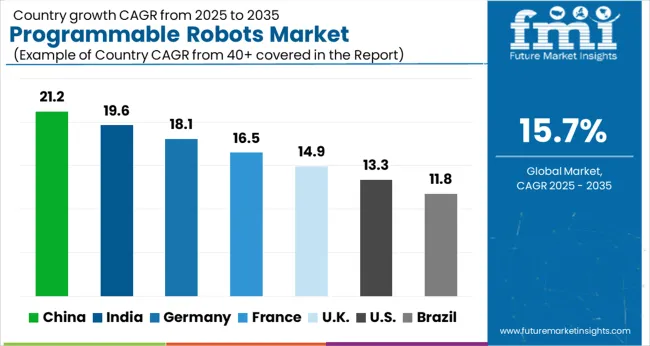
| Countries | CAGR |
|---|---|
| China | 21.2% |
| India | 19.6% |
| Germany | 18.1% |
| France | 16.5% |
| UK | 14.9% |
| USA | 13.3% |
| Brazil | 11.8% |
The global Programmable Robots Market is projected to grow at a CAGR of 15.7% through 2035, supported by increasing demand across education, research, and industrial training applications. Among BRICS nations, China has been recorded with 21.2% growth, driven by large-scale production and deployment in learning and automation platforms, while India has been observed at 19.6%, supported by rising utilization in academic programs and industrial skill development. In the OECD region, Germany has been measured at 18.1%, where production and adoption for engineering, manufacturing, and training purposes have been steadily maintained. The United Kingdom has been noted at 14.9%, reflecting consistent use in education and research institutions, while the USA has been recorded at 13.3%, with production and utilization across training, industrial, and academic applications being steadily increased. This report includes insights on 40+ countries; the top five markets are shown here for reference.
The programmable robots market in India is expanding at a CAGR of 19.6%, driven by its growing emphasis on digital education, industrial automation, and skill development. Indian schools, training centers, and universities are adopting programmable robots to teach coding, problem-solving, and STEM skills. This trend is reinforced by government programs such as “Digital India” and “Skill India,” which focus on building a future-ready workforce. In industries such as automotive, electronics, and manufacturing, programmable robots are increasingly used to improve operational efficiency and reduce human error. Additionally, India’s thriving startup ecosystem is fostering innovation by developing affordable and customized robotics solutions for both domestic and global markets. The healthcare and service industries are also exploring robotic applications for assistance and automation. With rising demand across multiple sectors, India is becoming one of the key high-growth markets for programmable robots.

Germany’s programmable robots market is advancing at a CAGR of 18.1%, supported by its strong industrial base, education system, and focus on Industry 4.0. Programmable robots are widely deployed in manufacturing facilities to optimize processes, support precision assembly, and enable smart factory operations. The country’s leadership in automotive and engineering sectors fuels demand for robotics solutions that enhance productivity and maintain quality standards. Education and research institutions in Germany are also incorporating programmable robots into curricula to train students in robotics, AI, and digital technologies. Furthermore, the German government and private sector are investing heavily in R&D and innovation, ensuring technological leadership in advanced robotics. The integration of AI, connectivity, and automation technologies is accelerating programmable robot adoption. With its strong regulatory support and industrial expertise, Germany remains one of the leading European markets for programmable robots.
The programmable robots market in the United Kingdom is growing steadily at a CAGR of 14.9%, driven by rising demand in education, research, and industrial sectors. British schools and universities are increasingly adopting programmable robots to support digital skills development and prepare students for AI-driven industries. The UK government’s focus on innovation, technology integration, and robotics R&D is also fueling growth. Industrial applications, including electronics, logistics, and advanced manufacturing, are adopting programmable robots to improve efficiency and address labor shortages. Additionally, the UK is seeing increased interest in service robotics, particularly in healthcare and public services. Startups and innovation hubs are playing an active role in making programmable robots more accessible and affordable. With its emphasis on education, digital transformation, and technological research, the UK programmable robots market is expected to grow consistently in the coming years.
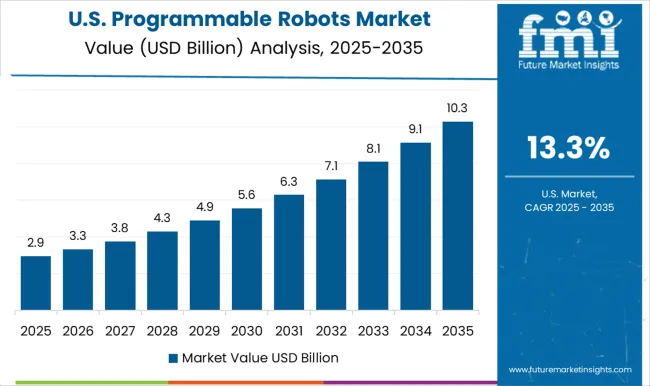
The programmable robots market in the United States is growing at a CAGR of 13.3%, supported by strong demand from education, industrial automation, and defense. Schools and universities are adopting programmable robots to teach STEM, coding, and AI skills, helping to prepare the next generation workforce. The USA is also a hub for advanced robotics R&D, with leading companies and startups continuously developing innovative programmable robots. Industrial sectors such as automotive, aerospace, and precision manufacturing use these robots to enhance productivity and maintain competitive advantages. In addition, the defense sector invests significantly in robotics for training, simulation, and operational applications. Government support for STEM education and digital innovation continues to boost market adoption. With its advanced technology ecosystem and broad application areas, the USA remains a crucial player in the global programmable robots market.
The programmable robots market in China is growing rapidly at a CAGR of 21.2%, supported by the government’s push toward automation, smart manufacturing, and robotics education. China is heavily investing in robotics under its “Made in China 2025” policy, which aims to strengthen the country’s global competitiveness in advanced technologies. Programmable robots are being widely adopted in schools and universities to enhance STEM learning, coding education, and artificial intelligence training, which creates strong future demand. In addition, the manufacturing and logistics industries are embracing programmable robots to improve efficiency, reduce labor dependency, and enhance precision. E-commerce giants and smart warehouses are increasingly integrating robotics into operations. With continuous investments in R&D, domestic production, and AI-powered robotics, China has established itself as the largest and fastest-growing market for programmable robots.
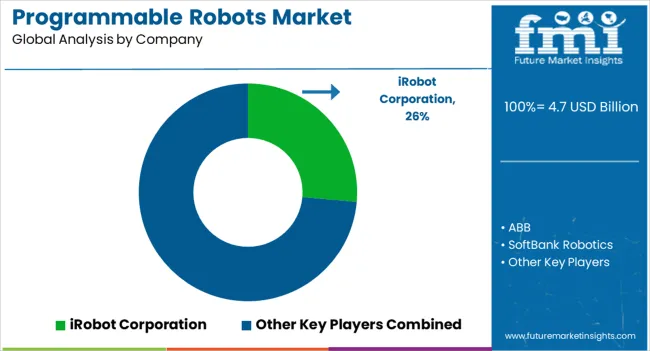
The growing adoption of STEM education, manufacturing, and service industries is driving strong market growth. iRobot Corporation is a key player, widely recognized for its consumer robots, such as the Roomba, while also advancing programmable robotics technologies for both household and research purposes. ABB leads the industrial robotics space with programmable robotic systems that enhance efficiency, safety, and productivity in manufacturing. SoftBank Robotics specializes in humanoid robots such as Pepper and NAO, which are widely used in education, customer service, and research environments.
The LEGO Group makes significant contributions through LEGO Education and LEGO MINDSTORMS kits, which make programming accessible to students and hobbyists worldwide. OnRobot A/S offers programmable robotic accessories and solutions that enhance collaborative robots (cobots), enabling companies to achieve flexible automation. ElephantRobotics specializes in robotic arms and open-source, programmable robots, catering to both educational and industrial applications. Fischertechnik GmbH, similar to LEGO, offers modular robotic kits that are widely used in STEM programs to teach programming, engineering, and robotics concepts. Together, these companies are making robotics more accessible and functional across sectors, from classrooms and research labs to factories and homes. Their innovations in programmable robotics are shaping the future of automation, education, and human-robot collaboration.
| Item | Value |
|---|---|
| Quantitative Units | USD 4.7 Billion |
| Component | Hardware and Software |
| Type | Educational robots, Industrial robots, Service robots, Research robots, and Others |
| End Use | Manufacturing, Healthcare, Entertainment and media, Military and defense, and Others |
| Regions Covered | North America, Europe, Asia-Pacific, Latin America, Middle East & Africa |
| Country Covered | United States, Canada, Germany, France, United Kingdom, China, Japan, India, Brazil, South Africa |
| Key Companies Profiled | iRobot Corporation, ABB, SoftBank Robotics, The LEGO Group, OnRobot A/S, ElephantRobotics, and Fischertechnik GmbH |
| Additional Attributes | Dollars vary by component, encompassing hardware, AI-software, and services; by application, such as education, research, manufacturing, and entertainment; by mobility type, including wheeled, humanoid, and modular robots; and by region, led by North America, Asia-Pacific, and Europe, with AI-enabled automation and STEM education powering growth. |
The global programmable robots market is estimated to be valued at USD 4.7 billion in 2025.
The market size for the programmable robots market is projected to reach USD 20.1 billion by 2035.
The programmable robots market is expected to grow at a 15.7% CAGR between 2025 and 2035.
The key product types in programmable robots market are hardware and software.
In terms of type, educational robots segment to command 38.6% share in the programmable robots market in 2025.






Our Research Products

The "Full Research Suite" delivers actionable market intel, deep dives on markets or technologies, so clients act faster, cut risk, and unlock growth.

The Leaderboard benchmarks and ranks top vendors, classifying them as Established Leaders, Leading Challengers, or Disruptors & Challengers.

Locates where complements amplify value and substitutes erode it, forecasting net impact by horizon

We deliver granular, decision-grade intel: market sizing, 5-year forecasts, pricing, adoption, usage, revenue, and operational KPIs—plus competitor tracking, regulation, and value chains—across 60 countries broadly.

Spot the shifts before they hit your P&L. We track inflection points, adoption curves, pricing moves, and ecosystem plays to show where demand is heading, why it is changing, and what to do next across high-growth markets and disruptive tech

Real-time reads of user behavior. We track shifting priorities, perceptions of today’s and next-gen services, and provider experience, then pace how fast tech moves from trial to adoption, blending buyer, consumer, and channel inputs with social signals (#WhySwitch, #UX).

Partner with our analyst team to build a custom report designed around your business priorities. From analysing market trends to assessing competitors or crafting bespoke datasets, we tailor insights to your needs.
Supplier Intelligence
Discovery & Profiling
Capacity & Footprint
Performance & Risk
Compliance & Governance
Commercial Readiness
Who Supplies Whom
Scorecards & Shortlists
Playbooks & Docs
Category Intelligence
Definition & Scope
Demand & Use Cases
Cost Drivers
Market Structure
Supply Chain Map
Trade & Policy
Operating Norms
Deliverables
Buyer Intelligence
Account Basics
Spend & Scope
Procurement Model
Vendor Requirements
Terms & Policies
Entry Strategy
Pain Points & Triggers
Outputs
Pricing Analysis
Benchmarks
Trends
Should-Cost
Indexation
Landed Cost
Commercial Terms
Deliverables
Brand Analysis
Positioning & Value Prop
Share & Presence
Customer Evidence
Go-to-Market
Digital & Reputation
Compliance & Trust
KPIs & Gaps
Outputs
Full Research Suite comprises of:
Market outlook & trends analysis
Interviews & case studies
Strategic recommendations
Vendor profiles & capabilities analysis
5-year forecasts
8 regions and 60+ country-level data splits
Market segment data splits
12 months of continuous data updates
DELIVERED AS:
PDF EXCEL ONLINE
Programmable Logic Device (PLD) Market Growth & Demand 2025 to 2035
Programmable Logic Controller Market Growth – Trends & Forecast 2024-2034
SLAM Robots Market Size and Share Forecast Outlook 2025 to 2035
Field Programmable Gate Array (FPGA) Size Market Size and Share Forecast Outlook 2025 to 2035
Micro Robots Market Analysis - Size, Share, and Forecast Outlook 2025 to 2035
Delta Robots Market
Field-programmable Gate Array (FPGA) Market
Mobile Robots Market Size and Share Forecast Outlook 2025 to 2035
Pharma Robots Market Size and Share Forecast Outlook 2025 to 2035
Nuclear Robots Market Size and Share Forecast Outlook 2025 to 2035
Kitting Robots Market Size and Share Forecast Outlook 2025 to 2035
Milking Robots Market Size and Share Forecast Outlook 2025 to 2035
Airport Robots Market Size and Share Forecast Outlook 2025 to 2035
CPLD Market – Trends & Growth through 2034
Painting Robots Market Size and Share Forecast Outlook 2025 to 2035
Security Robots Market Size and Share Forecast Outlook 2025 to 2035
Military Robots Market Size and Share Forecast Outlook 2025 to 2035
Surgical Robots Market
Pipetting Robots Market Size and Share Forecast Outlook 2025 to 2035
Logistics Robots Market Size and Share Forecast Outlook 2025 to 2035

Thank you!
You will receive an email from our Business Development Manager. Please be sure to check your SPAM/JUNK folder too.
Chat With
MaRIA